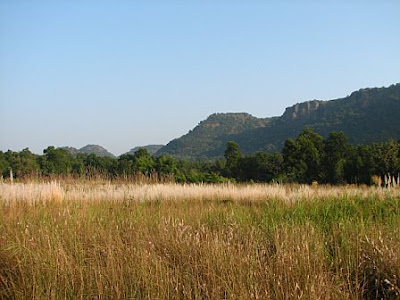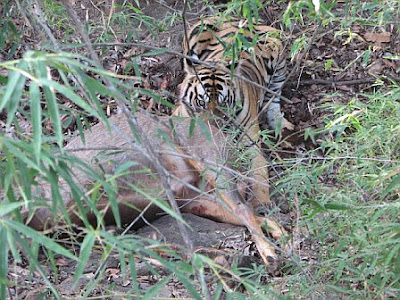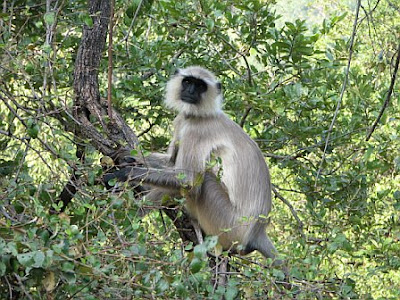Bandhavgarh National Park is spread over the vindhya hills in Madhya Pradesh. It consists of a core area of 105 sq km and a buffer area of approximately 400 sq km of topography varies between steep ridges, undulating, forest and open meadows. The density of the Tiger population at Bandhavgarh is the highest known in India.

It has around 64 tigers (according to the guides and it certainly does seem that way.) Most of the land is hilly, rocky terrain which keeps the tigers relatively in a high concentration and increases a chance of sighting. The jungle itself, is not as beautiful as Kanha - which has very scenic forests ( More on Kanha in the next blog)

CharkraDhara - The centre plain.
Getting there
Bangalore to Mumbai - Flight ( Kingfisher Airlines )
It was our first experience with KFA, great service and a very enjoyable flight with surprisingly wonderful food (for an airline).
Mumbai to Katni
Train number: 1071 Kamyani Express
Timings : Dep 12:40pm Arr (Next Day) 9:50am
The train was taken from Kurla Station, which was without doubt one of the dirtiest stations I’ve seen. Even the first class waiting rooms are awful. There is a relatively good book stall in the station though. The toilets must be awful for I could smell them a mile away.
There was practically no food available on the train (no pantry car) and the stations along the way did not yield any gastronomic delights either. Fortunately for us, we took some cookies to munch on. The scenery was not very inspiring; take along a good book (I read Gone with the wind) or some other diversion.
Katni to Bandhavgarh (105 Km )
Katni is a tiny little village/town. Theres a pedestrian over bridge to be crossed to reach the exit gate, travel light, the trolley bags won’t be of any use here.
Our hotel arranged a pickup at Katni Station. We travelled in a Sumo on a dusty bumpy track blasphemously called a road. Time taken – 3.5Hrs Cost Rs.2100
Where to stay
We stayed at the Tiger Trails Lodge. Wonderful, well furnished cottages with extremely comfortable beds and clean bathrooms. Food is decent (They try very hard to Europeanize it; it doesn’t have its natural spicy flavor.) Tea in particular, is the insipid European-make-your-own kind. But I found that if you ask, they are most happy to serve proper Indian 'cha' as well. There is no typically Madhya Pradesh cuisine, apparently. So the food is a kind of generic north Indian fare. Hardly any Indian guests there, so the staff will be delighted to converse with you in Hindi. Very friendly, and they all have interesting jungle stories to tell.
Cost: per head, per 24 hr day:
Rs.2500 (inclusive of boarding, lodging and 2 park safaris)
Jungle & Safaris
The park is very well managed and maintained. Having seen all of South India's parks, I feel the south can do well to learn from MP.
There are 2 safaris per day Morning 6am to 12pm and 3pm to 6pm.

Langoors, Female with baby
The jeeps line up at the gate and the park opens at sharp 6am. Each jeep gets a guide from the forest department, in addition to the driver from resort who serves as another guide. All jeeps are similarly equipped.

Badi Guffa - Caves where we had breakfast
The guides are local people, they speak Hindi and if you can converse in it, you are in for a treat.
The morning safari carried our breakfast, which is eaten picnic style off the bonnet of the jeep at a center camp of the forest while waiting for the tiger to be sighted by elephant.
The elephant show
It sounds like a circus event, but it’s actually well worth doing once.

Our Mahut and Elephant - Balram
The elephants go out at around 4 am and scour the forest to sight one or more tiger. Once it is found, the camp is informed and the jeeps are given numbers and queued up to see the tiger on elephant back. Costs: Rs.100 per person. Our Mahut was very gentle with his elephant and was very helpful in getting great pictures, so we tipped him generously. If you take his snap with the elephant, you can be guaranteed he’ll be mighty pleased.

It is exciting, to see the tiger so close and the pictures that you get are amazing. We did 2 such shows in Bandhavgarh, for we were not lucky enough to see the tigers on jeep.
Being a small park, it is well managed and the tiger sighting is well controlled and does not reduce to a chaotic scramble. Care is taken to see that the animals are not disturbed.

The forest is quite dense and not very scenic. But the concentration of tigers is quite impressive. In all of the national parks we visited, tourists would ask "did you see the tiger?" here they ask you, "How many have you seen today?" We met a couple from York who saw 13 different tigers in a single day from the jeep.
Sightings
Tigers(2M,3F) Lagoors, Barking deer, Spotted Deer, Sambar Deer, Jungle Cat. One Tiger was with Kill. ( Major Bonus)


Tree Pie, Wag Tail, Rufus backed Shrike, Rose Ringed Parakeets, Peacocks, Serpent Eagle, Golden backed woodpecker, Grey Hornbill, Wood Owl, Red vented bulbul, Jungle fowl, Lesser Adjutant crane.

Red Vented Bulbul
Best time to visit
April-May or Nov-Jan Park is closed during the monsoon. We visited in Nov. The Guides said that visiting in the summer months ensures a better sighting, since water is scarce. However, there is also a tourist rush and the weather is unbelievably hot.
Weather
Its freezing in the mornings ( by indian standards ) around 15 C. Carry lots of warm clothing. As the day progresses it becomes increasingly warmer and by 12 noon it is quite hot. The sun is very harsh, carry sunscreen. Wear a scraf or hat to cover your ears and hair (its very cold in the morning and dusty later). Sunglasses are a must. Binoculars are also a must and the guide will usually have a pair too ( but they arent very good )
What I liked
Park was very clean, practically spotless. There are little makeshift toilets inside the park as well. No water is available there, though. Guides are well informed and very polite. The tiger show was very well managed, with minimum inconvenience to the tigers.
Wild Chalet organized a little tribal dance for their guests. It was quite nice. The tribal ladies were a bit shy at first but later, got quite pleased with the response from the small but enthusiastic gathering. The men performed some rather dangerous looking acrobatic feats as well. There was a large australian group at the resort and the ladies were coaxed into joining the dance, I rather think it was a fun way tp involve the tourists.
What I didnt like
The souvenir shop at the park left much to be desired. There is a better one (privately owned) just outside the park.





























